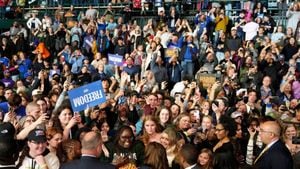The countdown to the 2024 U.S. presidential election has reached its final hours, with Vice President Kamala Harris and former President Donald Trump locked in what many describe as one of the tightest races in recent history. Polls indicate this election could be decided by the smallest of margins, with voters divided almost evenly across key demographics and regions. With millions of registered voters heading to the polls, the stakes could not be higher for both candidates, each vying for the opportunity to lead the nation through the next four years.
Polling data released just before Election Day shows Harris slightly leading Trump nationally, with the most recent NPR/PBS News/Marist survey indicating she enjoys support from 51% of likely voters compared to Trump's 47%. This slight edge, though, is complicated by the fact the race remains exceedingly close, highlighted by various swing state polls, including those from Emerson College Polling and HarrisX, which suggest multiple states are too close to call.
According to Emerson polls, Harris holds narrow leads over Trump in swing states like Michigan, where she is up by two points, 50% to 48%. Meanwhile, Trump leads by small margins in states like Pennsylvania and North Carolina, where he enjoys one-point advantages. Overall, the current estimates show Trump leading Harris slightly among independent voters, which could play a significant role as they could sway the results of tightly contested races across the country.
One of the most telling aspects of this election is the distinct gender gap observed among voters. Data indicates considerable polarization, with men primarily leaning toward Trump and women supporting Harris. For example, Harris claims 55% of women's votes, compared to only 43% for Trump. Conversely, Trump garners substantial support from men, with varying degrees of advantage across different states.
Another pivotal factor affecting the election is the significant early voting trend. Approximately 55% of likely voters reported they had already cast their ballots, with Harris receiving majority support from early voters at 56%. This contrasts with Trump’s 53% among those yet to vote. Given the dynamics of early voting and absentee ballots, the final count might take days, particularly since some states, like Pennsylvania, do not process mail-in ballots until Election Day.
The issues at play also reflect voters' priorities, which include inflation and the preservation of democratic processes. Surveys show 31% of likely voters stress the importance of democracy, casting light on the overall sentiment surrounding the political climate. Issues such as inflation and healthcare trail closely behind, emphasizing the diverse concerns of the electorate.
The candidates have adopted strategies to target different voter demographics. Harris seeks to appeal more broadly, focusing on unity and recovery from divisive politics, particularly aiming to engage younger voters and moderates who may feel alienated by Trump's often combative rhetoric. Conversely, Trump utilizes his typical messaging style, favoring rallying his base and addressing perceived grievances related to the current administration.
Harris’s campaign has emphasized grassroots movement, backed by numerous volunteer actions, such as knocking on millions of doors to secure voter turnout. The intensity of both campaigns is palpable, as seen through numerous scheduled rallies and media engagements leading up to the election.
Despite these efforts, both candidates face skepticism from portions of the electorate. A notable section of respondents indicated they are unsure of Harris's commitment to her proposals, reflecting historical ambivalence toward politicians' promises. The NPR/PBS News/Marist poll revealed voters are split—49% believe Harris will enact her plans, whereas another 49% think her promises are merely political maneuvers.
Interestingly, the electoral map outlines distinctive patterns, with Harris performing particularly well among voters residing in urban and suburban areas, garnering significant support from college-educated individuals and women. The performance among minority groups also demands attention; Harris leads among Black voters with 83% support and enjoys favorable ratings from key Latino demographics, albeit with some declines compared to previous elections.
Simultaneously, Trump continues to excel among rural voters and those identifying as white evangelicals, sustaining his core base which largely favors traditional, conservative values. This demographic reality places the emphasis on Harris to consolidate support across various groups to successfully navigate through battleground states.
The election is not taking place without the backdrop of concerns surrounding potential post-election violence, with significant percentages of voters expressing apprehension. With 72% of voters indicating they worry about unrest following the election, it reflects the tense atmosphere surrounding voting and the associated uncertainties.
Harris's strategies revolve around portraying herself as someone ready to lead the future, contrasting with Trump's narrative of returning to previous policies and promises of greater economic control. Each candidate has positioned themselves carefully concerning their distinct appeals, ensuring they address the pressing concerns of the election season.
With the clock ticking down to results night, the race's developments are being closely monitored as both campaigns make final efforts to persuade undecided voters remaining on the fence. The next few days will likely prove pivotal; small shifts among key demographics, particularly independents and moderates, could alter the already precarious balance of the race, making it imperative for both candidates to seize every opportunity.
With eyebrows raised at forecasted outcomes and the potential for recounts should the margins remain as close as they currently stand, the nation watches and waits for what goes down on Election Day. No matter the result, the spectator nature of this election will roll out consequences for both parties moving forward as each attempts to adapt to the shifting sands of American politics.



